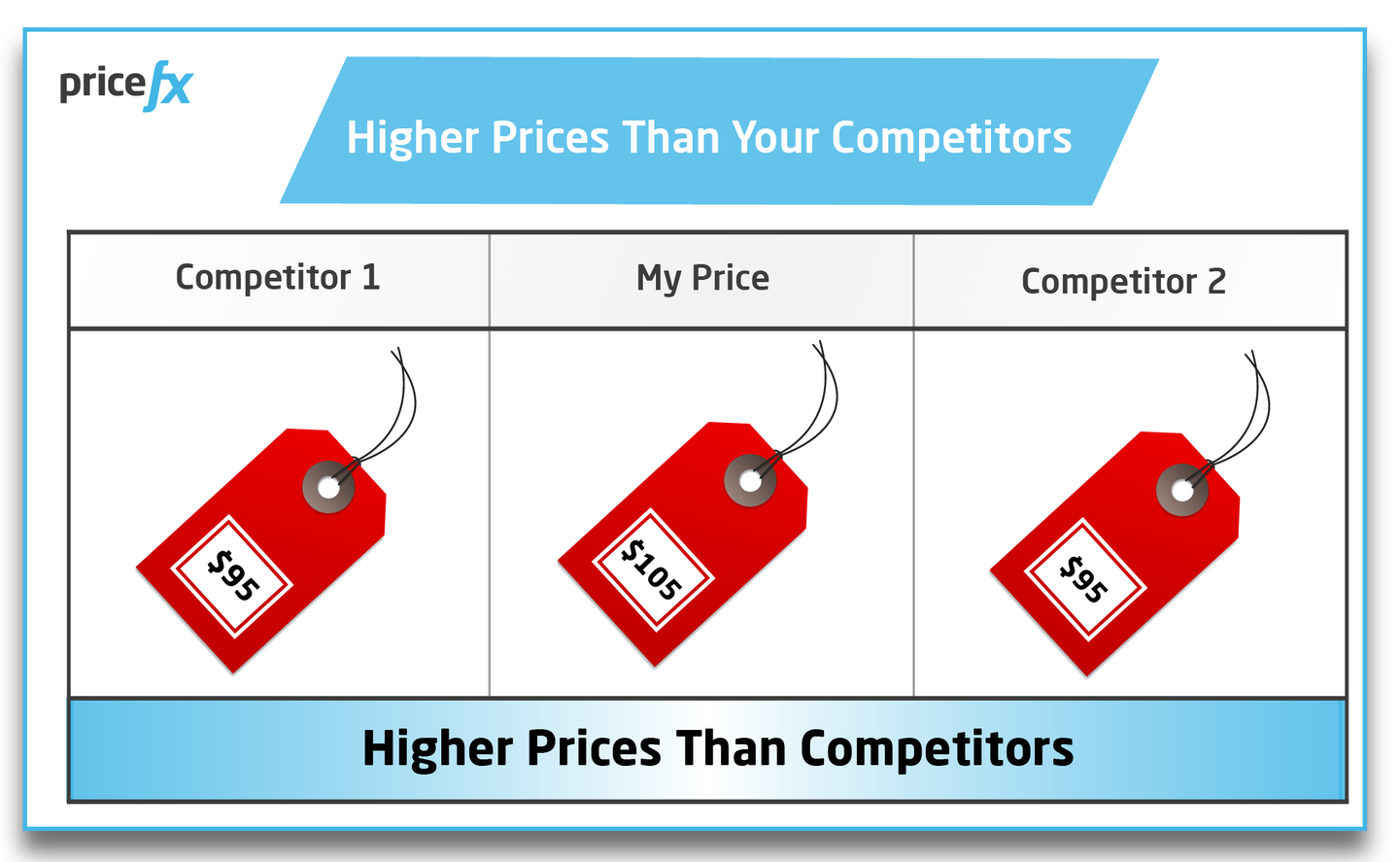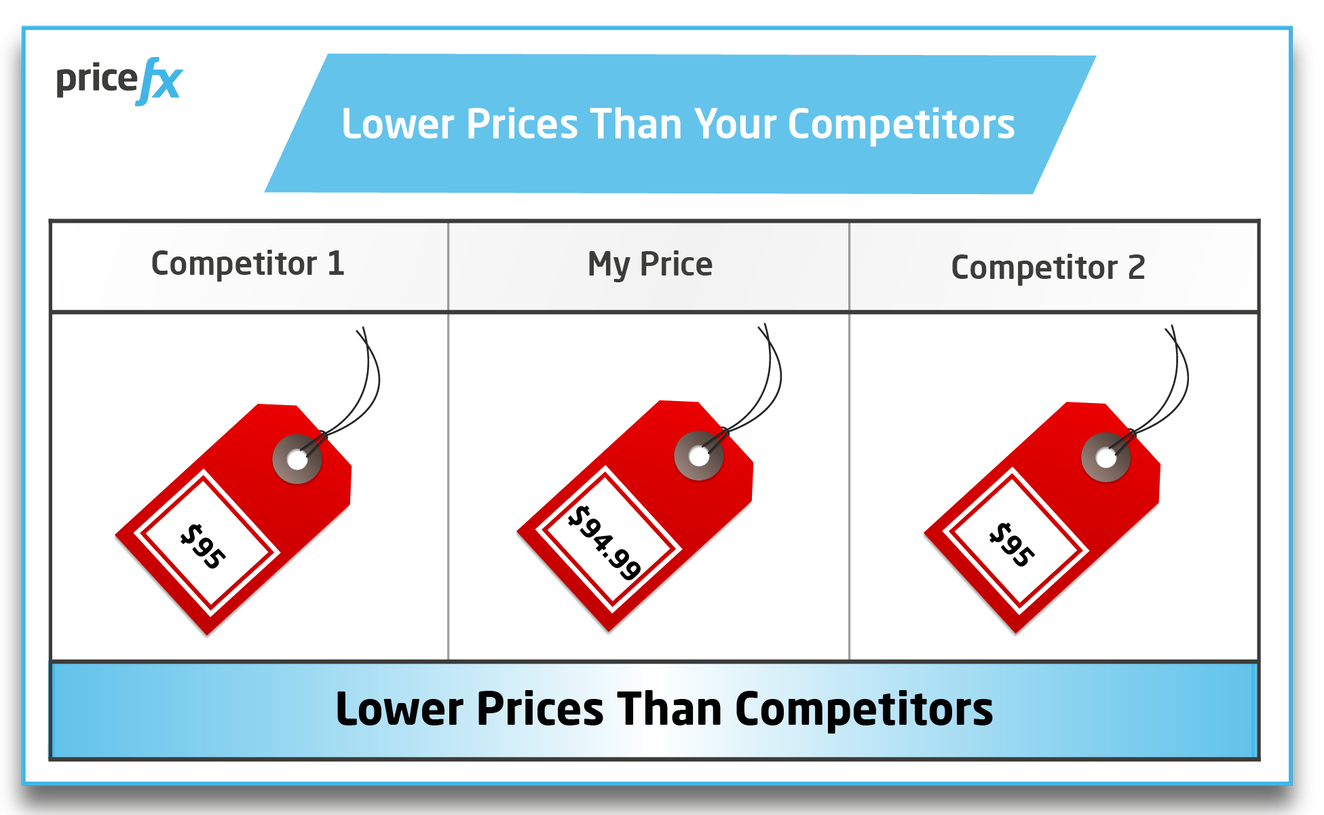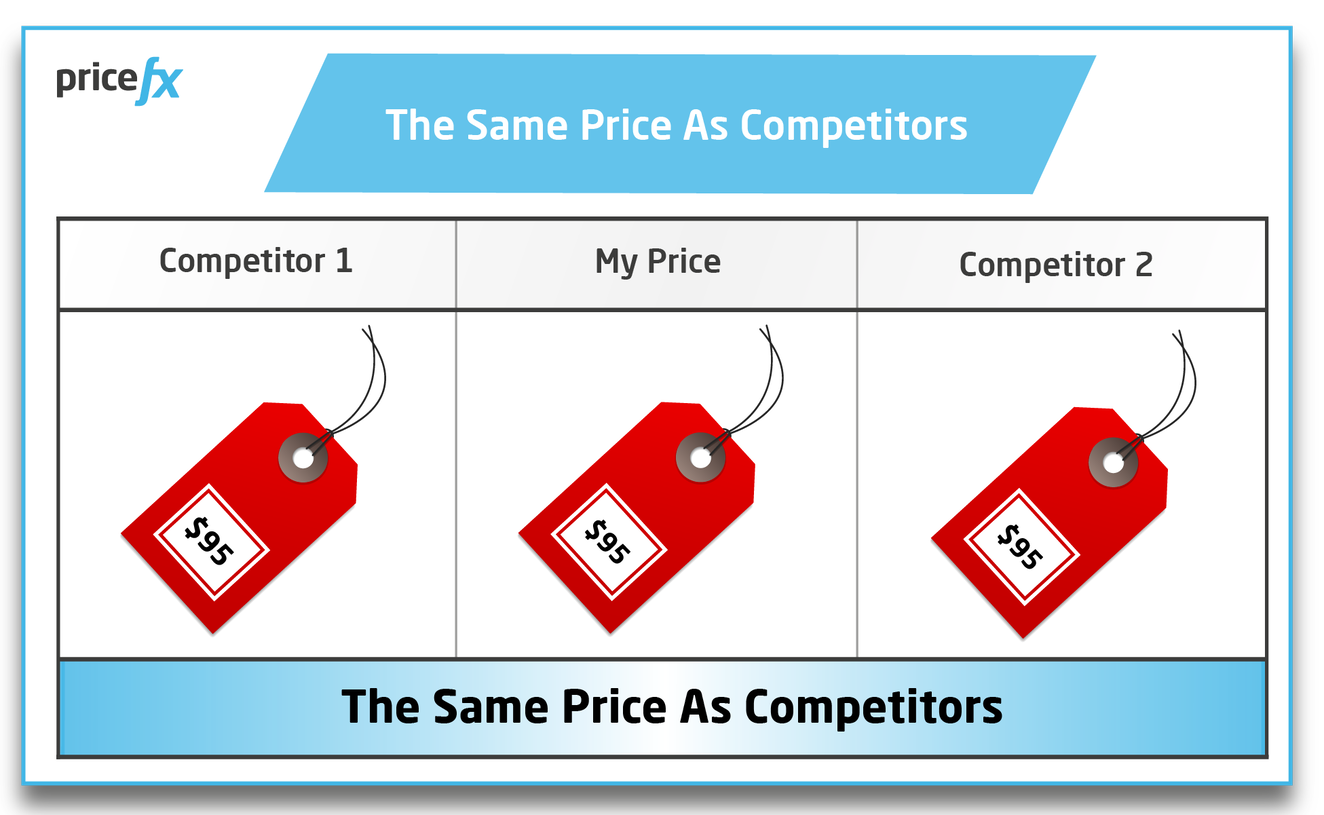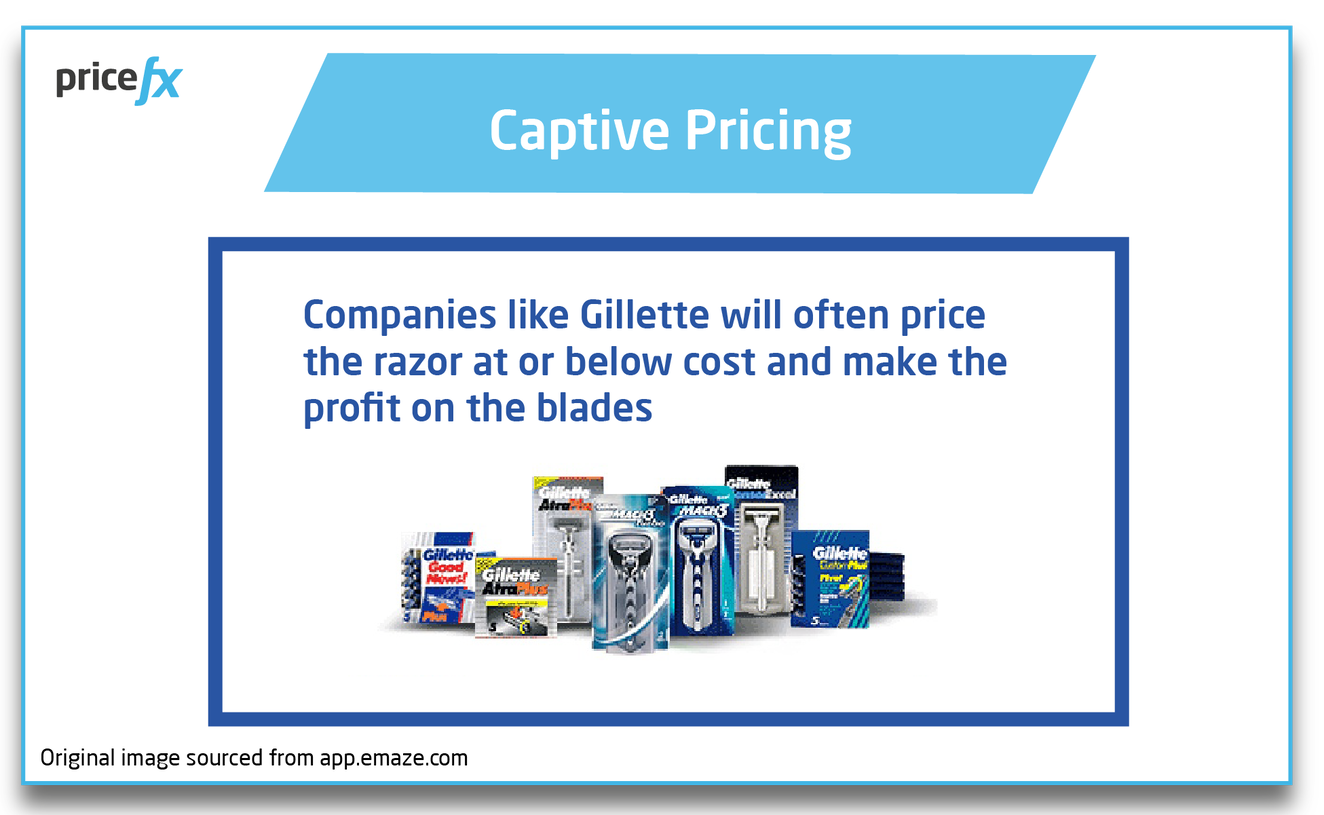Competitive Pricing Strategy Explained: The Pros & Cons
February 25th, 2022 (Updated 03/10/2023) | 13 min. read
By Ken Edwards
Pricing your products and services can be a tough assignment for any business. If you set your prices too low, you might leave valuable profit at the checkout. On the flip side, if you set your prices too high, you might risk not getting the sale in their first place. Thankfully with each passing year, pricing is becoming more about science and less like a lucky flip of the coin. There are plenty of methodical pricing models and strategies that can help set the right prices for your customer and business objectives. In this article we analyze just one example of several different pricing strategies; Competitive Pricing Strategy Explained: The Pros & Cons.
At Pricefx, we have assisted hundreds of companies over the last 10+ years in optimizing their pricing and learnt that no two businesses are identical in what they need from a pricing strategy solution. After reading this article, you may decide that a competitive pricing strategy might be just the thing for your business, but for another company it might not be suited at all.
To help you decide, let’s examine exactly what a Competitive Pricing Strategy is, your company’s competitive pricing strategy choices, refined competitive pricing strategy types to achieve specific outcomes, the most famous competitive pricing strategy and the strategy’s pros and cons.
What is Competitive Pricing Strategy? – The Definition
A Competitive Pricing Strategy is also known across the pricing industry as competitive-based pricing or competitor-based pricing.
What that means is that a competitive pricing strategy is a pricing method that involves setting the prices of your businesses’ products in relation to the prices of your competitors.
It is a type of pricing strategy that is in direct comparison to other pricing strategies like cost-plus pricing or value-based, where prices are determined by analyzing other factors like consumer demand or the cost of production. A Competitive Pricing Strategy focuses entirely on publicly available information about your competitor’s prices, not customer value.
Usually, companies decide to use a Competitive Pricing Strategy that usually compete in heavily saturated marketplaces, since just a small difference in price can make the deciding point of difference in getting the sale or not.
When adopting a Competitive Pricing Strategy, you generally price your products slightly below your competitors, the same as your competitors, or slightly above your competition. For example, if you are selling 10-pound bags of coffee and your competitors’ prices range from $60 to $80, you’d choose a price between those two numbers, say $72.
Whichever price you choose in the example above (from $61 to $79 or any dollar figure in between), a Competitive Pricing Strategy is one way to stay on top of your competitors and maintain dynamic pricing.
Your Company’s Competitive Strategy Pricing Choices

With a Competitive Pricing Strategy, your business will have choice of 3 pricing alternatives —price your product higher, lower or the same as your competitors:
1. Higher Prices Than Your Competitors
If you are planning to set the price above the price of your competitors, then you would need to exhibit or introduce new improvements or features in your products that would justify the increased price.

Furthermore, when pricing above your competition, it is sometimes possible due to the high price-quality association among your potential customers. But beware, online consumer reports and other similar publications put objective product comparisons within the reach of everyone these days. Today, hundreds of dot.com companies provide objective price comparisons. It will be essential to prove to your customers that your product justifies its premium price tag.
2. Lower Prices Than Your Competitors
Pricing below your competitor will depend on your company’s resources. If you can increase the volume of units without adding to your production cost to any great extent, then this could be a good pricing strategy for your business. However, you will need to be aware that there is a risk of eating into your profit margin, and you may not be able to recover your sunk cost and in the worst-case scenario, put yourself at risk of losing your business.

What’s more, pricing lower than your competitors can also be used as a marketing technique (however, check in your jurisdiction as it is illegal in certain areas). The technique’s objective is to increase traffic to your business based on pricing some products lower than competitors. Once the potential customer enters the bricks-and-mortar or online store environment, and makes their low-cost purchase, the hope is to attract them to other products that generate profit. New customers to a store can be attracted and it can also assist businesses in moving stagnant inventory.
3. The Same Price as Your Competitors
When you set a price equivalent to your competitor’s, then all points of price differentiation cease to exist.
The focus instead shifts to the product itself and whatever extra, added or better features you can offer on your products over those of your competitors.
Anyone old enough to remember might recall when U.S. airlines were regulated, and all point-to-point airline tickets were the same price. Airlines offered steak or lobster meal menus as a point of difference to their competitors, whilst some catered to those customers wanting to drink free French champagne all 5-hour JFK – LAX flight long.

Additionally, you may notice every Holiday Season that the largest Ecommerce sites like Amazon drop their prices on millions of different items. Soon, other big Ecommerce sites like Best Buy or Walmart generally price match across the same items.
In this case, by adopting a Competitive Pricing Strategy, Walmart and Best Buy are offering the same prices to their customers without any risk of losing their clients’ business to Amazon on price alone.
More Refined Competitive Pricing Strategies to Achieve Specific Business Goals
With a competitive pricing strategy, you can customize your strategies to achieve specific business objectives by utilizing a refined strategy type.
For example, established businesses may be able to leverage promotional pricing to boost revenue and volume. Newer ventures may potentially use penetration pricing to make themselves noticed in the marketplace. Finally, organizations that are looking to increase sales on their core products can adopt captive pricing.
Promotional Pricing
Who doesn’t love a bargain? That is the psychological trigger behind promotional pricing. Frequently, businesses that operate with a high volume of products find promotional pricing an attractive way to boost revenue and increase sales by using a smaller than usual profit margin.
Penetration Pricing
Penetration pricing is a great pricing strategy for new businesses in the marketplace, or an organization that is looking to introduce a new service or product at a price that makes customers sit up and take notice. For example, imagine a telecommunications provider is introducing a new $99 per month ‘unlimited calls and 500GB of internet’ package at an introductory rate of $49.99 per month. A ‘disruptor’ telco service may possibly use this strategy to lure customers from a competitor or snag price-sensitive and first-time customers.
Captive Pricing
Captive pricing is a pricing strategy devised to attract a large volume of customers to a one-time purchase of a lower-priced core (or main) product that requires accessory (or captive) products for the main product to function. Anyone who buys razor blades or toner and ink cartridges for their printer knows all about captive pricing.

The objective of captive pricing is that the company may eventually enjoy increased revenue and sales through the recurring purchases of more profitable accessory products.
Pepsi vs Coca Cola – The Most Famous Competitive Pricing Strategy
Arguably the famous head-to-head between two companies employing competitive pricing strategy is Pepsi vs Coca Cola.
There are differences between the two companies (in particular, Pepsi is more diversified in terms of having a lot more offerings in their product line other than drinks). However, the two companies go directly head-to-head with their Cola drinks products.

While at any given point in time the two companies can vary in price, looking in general over the last decade or more, Pepsi is slightly cheaper than Coca Cola over the long term.
Recently, how it has worked is that Pepsi sets prices low and Coca-Cola has been the price follower. It is a classic case of competitive pricing and value branding.
That is reflected in the two companies’ most recent full year results with Pepsi generating more income in 2021, while Coca-Cola is the more valuable brand name (Number 7 worldwide in 2021 compared to Pepsi’s number 36).
The Pros of a Competitive Pricing Strategy

There are several benefits to consider when thinking about whether you should employ a competitive pricing strategy in your business;
1. Simplicity – A Competitive Pricing Strategy is Easy to Run & Maintain
A competitive pricing strategy model is quite simple to implement as it requires only basic research and insight into who your competitors are and what they are up to with their products and prices. You might even be able to make the decision to implement it and have it running the same day.
Over the long term, however, if your business will be looking to hold to as much profit as possible with a competitive pricing strategy, investing in a price comparison tool or pricing software will be essential to your success. Staying connected with what your competitors are up to with their prices with the use of a fully automated price tracking process will provide you with access to price intelligence that your competitors may find difficult to gather manually.
2. A Competitive Pricing Strategy Is Low Risk & Can Show Quick Results
Implementing a competitive pricing strategy for your company can help your business grow quickly, and the results can become apparent after a short amount of time. As results can been quickly, business owners can assess overarching price trends and effectively understand what their next price steps will be quicker than usual and align their business objectives accordingly.
In other words, enriching your own knowledge about your competitors can allow you to make a better business decision, which can increase your chances of short-term business success.
Again, if it is knowledge you want, an automated comparison tool will assist you to make faster and better decisions.
Since you are basing your pricing on that of your competitors, the Competitive Pricing Strategy is inherently low risk. As a collective group, you’ve all potentially been aligned in your respective industries for some time, so the chances are slim that your pricing strategies as a group could all flop simultaneously.
3. A Competitive Pricing Strategy Gets You Noticed & Increases Traffic
Whether you have an online shop or a bricks-and-mortar store (or both), using a competitive pricing strategy will help you get your brand out there in the public domain, gets your business noticed, increases foot traffic, and sows the seeds of brand loyalty for your products.
Making your prices the same as your competitors or even cheaper, consumers will be less likely to move from your brand or choose your competitors’ products over your own, thus enabling you to maintain or even potentially build your market share.
If you are responding to every move your competitors make, it only stands to logically reason that a competitive pricing strategy can further assist in a better positioning of your business.
4. A Competitive Pricing Strategy Can Be Used in Combination with Other Pricing Strategies
A Competitive Pricing Strategy is only one of the major pricing strategies. Other pricing strategy options can include cost-plus pricing, value-based pricing, markup pricing, and demand pricing.
Just like using a combination of alternative herbal medicines together with traditional science-based treatments can be advantageous, so too, a combination of pricing strategies may be best for achieving your company’s business health.
For example, your company might prefer to initially calculate your pricing based on a value-based or cost-plus pricing. However, before settling in at a purchase price solely based on those two strategies, you might wish to compare your prices with that of the competition and calibrate your pricing a little with your competitors. You might need to drop back a little to better compete, or you might be even able to increase your prices a little (make a little more profit per unit than you anticipated) and still be under the price of your competitors.
What’s more, if needed, flexibility is there to price different sets of your products using alternate pricing strategies.
The Cons of a Competitive Pricing Strategy
1. A Competitive Pricing Strategy Can Lead to Missed Opportunities
Simply copying your competitor’s prices might have short-term wins, but there is also a tendency to generate a lot of wrong prices and lost profits along the way, even if you do a diligent job of keeping track of your competitor’s price moves.
The overall goal of your business eventually should be to maximize revenue and profits, even if it does take a little bit of extra work and proactivity for your pricing team.
2. What If Your Competitor Makes a Mistake in Their Pricing & You Follow It? – Oops!
Totally relying on your competitor to set prices correctly can be very risky. What if they make a mistake, and you pass on that mistake to your clients? Not only does your company and your competitor both develop a bad reputation, but the mistake can send ripples of distrust across your entire industry and potentially erode consumer confidence.
What’s more, your business may possibly keep the same price forever, because your competitor is sitting tight on their prices to keep their clients happy, but all the while your company is hemorrhaging millions in potential profit.
It is your business, your product, your revenue, and it is worthwhile to keep that in focus.
3. A Competitive Pricing Strategy is Short Term & Can Erode the Value of Your Products
While it is easy to administer, maintaining equivalent or lower prices than your competitors are not the only ways to attract customers. Conversely, what a Competitive Pricing Strategy can do is set a mentality in place that prices must constantly be lowered to that of competitors. The problem arises that the lowering of prices in most industries can lead to doubts about quality and lower revenue from already shrunken profit margins even though customers may be willing to pay more.
As we have alluded to above, a “set it and forget it” mentality can develop with Competitive Pricing Strategy.
At its best, pricing is a science requiring data and attention.
If you are not changing your prices and differentiating your products over time, you are constantly subject to the whims of your competitors.
How to Combine a Competitive Pricing Strategy with Other Options
Now you know what a Competitive Pricing Strategy is, and its Pros and Cons, the big take away you’ve learnt is that it works best when used in combination with a range of other pricing strategies.
Pricing Software is the most efficient way to gather and analyze competitor information, in addition to implementing those different strategies. Rather than constantly monitoring competitors’ prices and adjusting your price lists, pricing software can also help you automate strategic pricing decisions, rather than manually collecting competitor data.
If you’re ready to learn more about implementing a holistic pricing strategy, check out this handy blog article;

